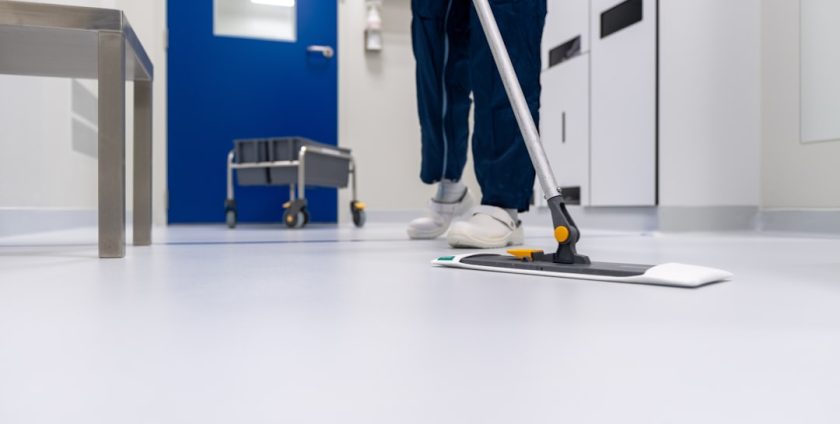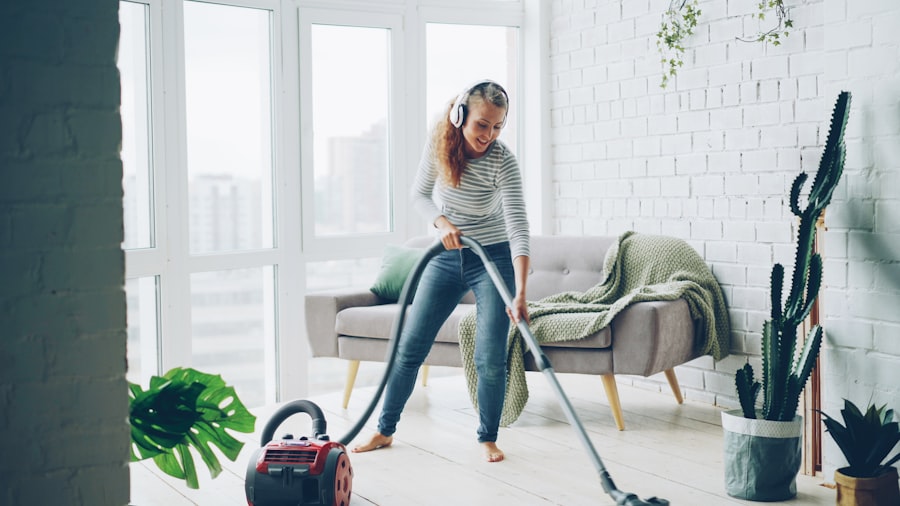
- By: admin
- Category: Commercial Floor Cleaning Machines
- 0 comment
In the realm of commercial and industrial cleaning, the efficiency of floor drying times is paramount. For facility managers and contract cleaners, understanding the significance of quick drying can lead to enhanced safety, improved aesthetics, and increased operational efficiency. Wet floors pose a considerable slip hazard, which can result in accidents and injuries, leading to potential liability issues for businesses.
Moreover, prolonged drying times can disrupt daily operations, causing inconvenience to staff and customers alike. Therefore, prioritising efficient floor drying is not merely a matter of cleanliness; it is a crucial aspect of maintaining a safe and productive environment. Efficient drying times also contribute to the longevity of flooring materials.
Whether dealing with hardwood, tile, or carpet, excessive moisture can lead to deterioration, mould growth, and unpleasant odours. For instance, in a busy retail environment, a wet floor can deter customers and negatively impact sales. By implementing effective drying strategies, facility managers can ensure that their floors remain in optimal condition while also fostering a welcoming atmosphere for patrons.
Ultimately, recognising the importance of efficient floor drying times is essential for any organisation aiming to uphold high standards of cleanliness and safety. Please feel free to get in touch with us through our Contact Us page.
Summary
- Efficient floor drying times are important for maintaining a safe and healthy environment, preventing mould and mildew growth, and minimising disruption to daily activities.
- Preparing the floor for quick drying involves removing excess water, cleaning up spills promptly, and ensuring proper ventilation in the area.
- High-powered fans and dehumidifiers can significantly speed up the drying process by increasing air circulation and removing excess moisture from the air.
- Choosing the right cleaning products, such as low-foaming and fast-drying solutions, can help to expedite the floor drying process.
- Properly ventilating the area by opening windows and using exhaust fans can help to facilitate faster drying and prevent moisture build-up.
Preparing the Floor for Quick Drying
Before embarking on the cleaning process, it is vital to prepare the floor adequately to facilitate quick drying. This preparation begins with a thorough inspection of the flooring type and its specific requirements. For example, different materials may react differently to moisture; thus, understanding these nuances can significantly impact drying times.
In an industrial setting, where heavy machinery may leave behind grease or oil, pre-treating these areas with appropriate degreasers can ensure that the cleaning solution penetrates effectively, allowing for a more efficient drying process. Additionally, removing any loose debris or dust from the floor before cleaning is crucial. This step not only enhances the effectiveness of the cleaning solution but also prevents the formation of mud or sludge that can prolong drying times.
In a warehouse environment, for instance, sweeping or vacuuming the floor prior to mopping can make a substantial difference in how quickly the surface dries. By taking these preparatory steps seriously, contract cleaners can set themselves up for success and ensure that their efforts yield optimal results.
Utilizing High-Powered Fans and Dehumidifiers

One of the most effective methods for expediting floor drying times is the use of high-powered fans and dehumidifiers. These tools work in tandem to create an environment conducive to rapid moisture evaporation. High-powered fans circulate air across the wet surface, increasing evaporation rates significantly.
In large commercial spaces such as shopping centres or office buildings, strategically placing fans can help direct airflow towards damp areas, ensuring that moisture is removed efficiently. Dehumidifiers play a complementary role by reducing the overall humidity in the air. In environments where humidity levels are high, moisture can linger on surfaces for extended periods.
For example, in coastal regions of Australia where humidity is prevalent, using dehumidifiers alongside fans can drastically improve drying times. By maintaining optimal humidity levels, facility managers can create a more comfortable environment while also protecting their flooring investments from moisture-related damage.
Choosing the Right Cleaning Products
Selecting appropriate cleaning products is another critical factor in achieving quick floor drying times. Not all cleaning solutions are created equal; some are designed specifically for rapid evaporation while others may leave behind excess moisture. For instance, using a low-moisture cleaning solution can significantly reduce drying times compared to traditional wet mopping methods.
In commercial kitchens or food processing facilities, where hygiene is paramount, opting for fast-drying disinfectants can ensure that surfaces are not only clean but also dry quickly to prevent bacterial growth. Moreover, understanding the chemical composition of cleaning products can aid in making informed choices. Many modern cleaning solutions are formulated with quick-drying agents that enhance evaporation rates without compromising cleaning efficacy.
For example, in an office environment where carpets are frequently cleaned, using a product designed for quick-drying can minimise disruption to daily activities while maintaining a pristine appearance. By prioritising the right cleaning products, facility managers can streamline their processes and achieve better results in less time.
Properly Ventilating the Area
Effective ventilation is often an overlooked aspect of floor drying but plays a crucial role in expediting the process. Ensuring that there is adequate airflow in the area being cleaned can significantly enhance moisture evaporation rates. In large industrial spaces or warehouses, opening windows and doors or using ventilation systems can help facilitate air movement.
This is particularly important in enclosed spaces where humidity can become trapped, prolonging drying times. In addition to natural ventilation methods, mechanical ventilation systems can be employed to improve air circulation. For instance, in facilities with central heating and cooling systems, adjusting these systems to promote airflow during and after cleaning can aid in reducing moisture levels quickly.
By prioritising proper ventilation techniques, facility managers can create an environment that supports efficient floor drying while also enhancing overall air quality.
Using Microfiber Mops for Faster Drying

The choice of cleaning tools can have a significant impact on drying times, and microfiber mops are among the most effective options available. Unlike traditional mops that tend to hold onto excess water, microfiber mops are designed to absorb moisture efficiently while leaving minimal residue behind. This characteristic makes them ideal for commercial settings where quick drying is essential.
In practice, using microfiber mops can lead to noticeable improvements in drying times across various environments. For example, in a busy hospital setting where cleanliness is critical, employing microfiber mops allows for rapid cleaning and drying of floors between patient visits. The reduced moisture left behind not only enhances safety but also contributes to a more hygienic environment overall.
By incorporating microfiber mops into their cleaning arsenal, contract cleaners can achieve superior results while minimising downtime.
Implementing Regular Maintenance and Deep Cleaning Schedules
Establishing regular maintenance and deep cleaning schedules is vital for ensuring that floors remain in optimal condition and dry quickly after cleaning. Routine maintenance helps prevent the build-up of dirt and grime that can complicate cleaning efforts and prolong drying times. For instance, in high-traffic areas such as lobbies or hallways, implementing a daily cleaning schedule can help maintain cleanliness and reduce the need for extensive deep cleaning sessions.
Deep cleaning should be strategically planned based on usage patterns and seasonal considerations. For example, during winter months when mud and moisture are prevalent, scheduling deep cleans more frequently can help mitigate issues related to dirt accumulation and moisture retention. By proactively addressing these concerns through regular maintenance and deep cleaning schedules, facility managers can ensure that their floors remain safe and presentable while optimising drying times.
Monitoring and Adjusting Drying Techniques for Different Floor Types
Finally, it is essential to recognise that different flooring types require tailored drying techniques to achieve optimal results. For instance, hardwood floors may necessitate gentler cleaning methods and slower drying processes to prevent warping or damage. Conversely, tile or concrete surfaces may allow for more aggressive cleaning techniques without compromising integrity.
Monitoring the effectiveness of chosen drying techniques is crucial for continuous improvement. Facility managers should assess drying times regularly and adjust their methods based on observed outcomes. For example, if certain areas consistently take longer to dry than expected, it may be necessary to reassess airflow strategies or consider alternative cleaning products better suited for those specific surfaces.
By remaining adaptable and responsive to the unique needs of each flooring type, contract cleaners can enhance their efficiency while ensuring that all surfaces are maintained to the highest standards. In conclusion, efficient floor drying times are essential for maintaining safety and cleanliness in commercial and industrial environments. By preparing floors adequately, utilising high-powered fans and dehumidifiers, choosing appropriate cleaning products, ensuring proper ventilation, employing microfiber mops, implementing regular maintenance schedules, and adjusting techniques based on flooring types, facility managers can significantly improve their operations.
The key takeaway is that investing time and resources into optimising floor drying processes not only enhances safety but also contributes to a more professional appearance and prolonged flooring lifespan. **FAQ Section** 1. **What are the best tools for speeding up floor drying times?**
High-powered fans and dehumidifiers are among the most effective tools for expediting floor drying times by enhancing airflow and reducing humidity levels.
2. **How often should I implement deep cleaning schedules?**
Deep cleaning schedules should be tailored based on usage patterns; however, high-traffic areas may benefit from weekly deep cleans while less frequented spaces could be cleaned monthly. 3.
**Can I use regular mops for commercial cleaning?**
While regular mops can be used, microfiber mops are recommended as they absorb moisture more effectively and leave less residue behind. 4. **What factors affect floor drying times?**
Factors such as humidity levels, airflow, type of flooring material, cleaning products used, and preparation methods all play significant roles in determining floor drying times.
5. **Is it necessary to ventilate after cleaning?**
Yes, proper ventilation is crucial as it helps remove excess moisture from the air and accelerates the drying process for cleaned surfaces.
FAQs
What are the benefits of significantly reducing floor drying times after a deep clean?
Reducing floor drying times after a deep clean can help to improve efficiency and productivity, minimize downtime, and reduce the risk of slips and falls. It also allows for quicker access to the cleaned area, which is particularly important in high-traffic environments.
What factors can affect floor drying times after a deep clean?
Several factors can affect floor drying times, including the type of flooring material, the cleaning method used, the humidity and temperature of the environment, and the airflow in the area. Additionally, the use of appropriate cleaning equipment and techniques can also impact drying times.
How can floor drying times be significantly reduced after a deep clean?
Floor drying times can be significantly reduced by using high-performance floor cleaning equipment, such as scrubber dryers or wet vacuums, that effectively remove excess moisture from the floor. Additionally, using drying fans or dehumidifiers can help to speed up the drying process.
What are some tips for reducing floor drying times after a deep clean?
Some tips for reducing floor drying times include using the appropriate cleaning equipment for the specific type of flooring, ensuring proper ventilation in the area, and using absorbent materials to soak up excess moisture. It is also important to follow manufacturer’s recommendations for cleaning and drying the floor.
Why is it important to follow proper drying procedures after a deep clean?
Following proper drying procedures after a deep clean is important to prevent potential safety hazards, such as slips and falls, and to maintain the integrity of the flooring material. It also helps to ensure that the cleaned area can be quickly put back into use, minimizing disruption to daily operations.
